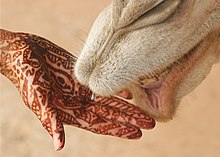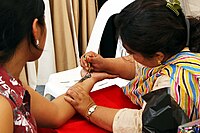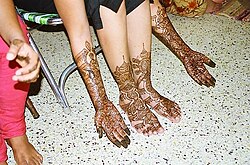Mehndi


Mehndi (also Mehandi, Mehendi, etc.) is the application of Henna as a temporary form of skin decoration in South Asia, Southwest Asia, North Africa and the Horn of Africa, as well as by expatriate communities from these areas. Mehendi decorations became fashionable in the West in the late 1990s, where they are sometimes called henna tattoos. Henna is typically applied during special occasions like weddings and festivals. It is usually drawn on the palms and feet, where the color will be darkest because the skin contains higher levels of keratin which binds temporarily to lawsone, the colorant of henna. Henna was originally used as a form of decoration mainly for brides.
The term henna tattoo is inaccurate, because tattoos are defined as permanent surgical insertion of pigments underneath the skin, as opposed to pigments resting on the surface as is the case with mehndi
Likely due to the desire for a "tattoo-black" appearance, many people have started adding the synthetic dye PPD to henna to give it a black color. PPD is extremely harmful to the skin and can cause severe allergic reactions resulting in permanent injury or death.[citation needed]
Alata (Mahur) is a flower-based dye used to paint the feet of the brides in some regions of India. It is still used in Bengal.
Process

Henna paste is usually applied on the skin using a plastic cone or a paint brush, but sometimes a small metal-tipped jacquard bottle used for silk painting (a jac bottle) is used. The painted area is then wrapped with tissue, plastic, or medical tape to lock in body heat, creating a more intense colour on the skin. The wrap is worn overnight and then removed. The final colour is reddish brown and can last anywhere from two weeks to several months depending on the type of the paste.
Tradition

There is evidence that mehndi as a ceremonial art form originated in ancient India. Intricate patterns of mehndi are typically applied to brides before wedding ceremonies see here. The bridegroom is also painted in some parts of India, Pakistan, Nepal, Bangladesh and Sudan. In Rajasthan (north-west India), the grooms are given designs that are often as elaborate as those for brides. In Assam, apart from marriage, it is broadly used by unmarried women during Rongali bihu (there’s no restrictions to the married ones).
In Arabic speaking countries such as Morocco, and some other countries in central Asia, it is done for any special occasion. It is done during the seventh month of pregnancy, after having the baby, weddings, engagements, family get-togethers, divali, as well as on other occasions.
Gallery
-
Sudanese woman with mehndi on Hands
-
Indian Woman with mehndi on Hands


